Clinical and translational research
Mass spectrometry (MS) is a powerful analytical technique that has become increasingly important in clinical research. It is a highly sensitive and specific method for identifying and quantifying molecules in complex biological samples, such as blood, urine and tissue. Today, you can detect and measure small molecules, proteins, peptides and metabolites in biological samples. This enables researchers to better understand the underlying mechanisms of diseases, identify biomarkers for early disease detection and diagnosis and develop more targeted and personalized treatments.
Engage with our wealth of experience in the ever-evolving field of cutting-edge clinical research. See how SCIEX technologies are utilized daily in identifying and quantifying new and emerging biomarkers and metabolites, whether they are small molecules, proteins or lipids. Learn how to empower your research while developing novel testing protocols for improving human health. SCIEX is the ideal partner for addressing these concerns and helping your clinical research laboratory meet its analytical goals now and in the future. We provide a strong portfolio of mass spectrometers, workflow solutions, software, aftercare and third-party relationships to meet and exceed your daily needs. In addition, as next-generation research into disease and medicine dictates the needs of tomorrow, you can be ready to respond with robust, sensitive and easy-to-use systems from SCIEX—such as the QTRAP 6500+ system—support the entire clinical research laboratory pipeline. Scientists trust us to advance their work in clinical research.
Metabolomics
Discover innovative metabolomics solutions that can help get you closer to your phenotype.
Lipidomics
See how simple, integrated LC-MS solutions can allow core labs and translational researchers to interrogate lipid profiles and reveal lipid species alterations that occur in metabolic disorders such as diabetes, obesity, hypertension, stroke and atherosclerosis.
Clinical proteomics
Clinical proteomics is a field of biomedical research that focuses on studying proteins in relation to diseases. By analyzing the proteome, researchers can better understand the molecular mechanisms of diseases, identify biomarkers and drug targets and advance diagnosis and treatment.
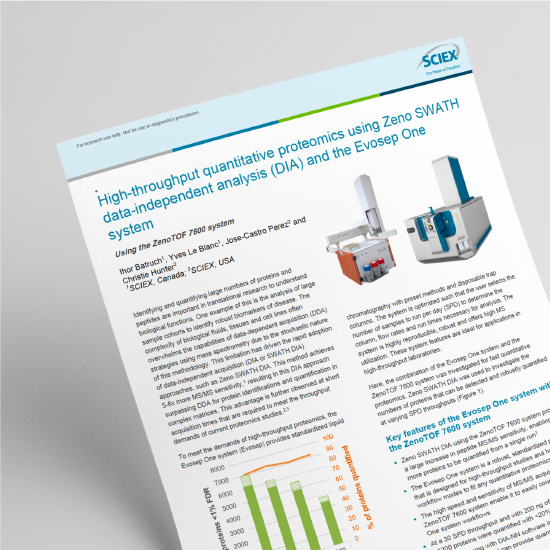
High-throughput quantitative proteomics using Zeno SWATH DIA and the Evosep One system
Analyzing large sample cohorts is critical when performing translational or biomarker research. Here, the combination of the Evosep One system and the ZenoTOF 7600 system was investigated for fast quantitative proteomics.
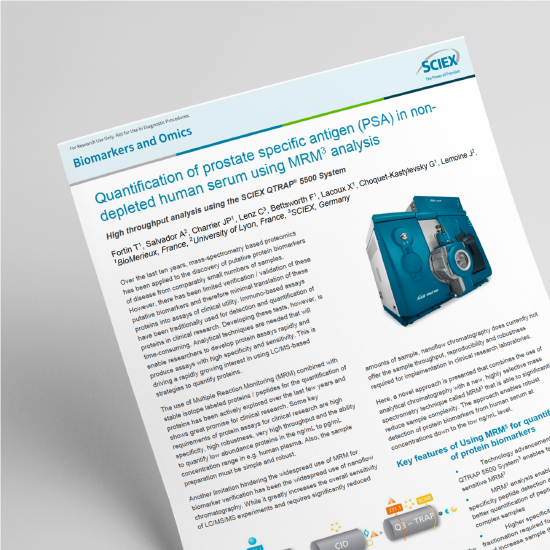
Quantification of prostate specific antigen (PSA) in non-depleted human serum using MRM3 analysis
MRM3 analysis enables higher specificity peptide detection and therefore better quantitation of peptides from highly complex samples. Improved detection of PSA in serum on the QTRAP 5500 system is demonstrated.
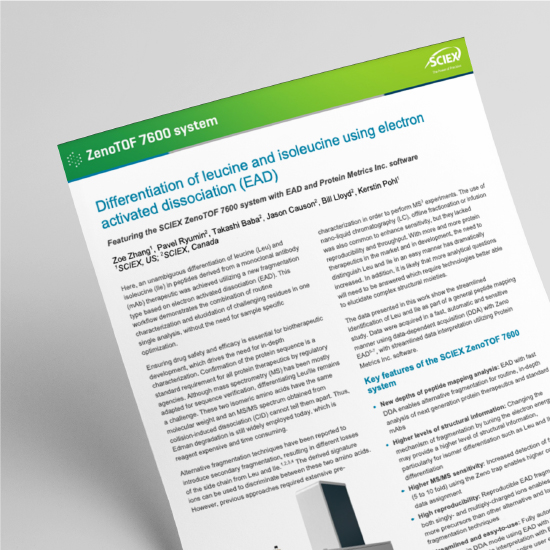
Differentiation of leucine and isoleucine using electron activated dissociation (EAD)
Here, an unambiguous differentiation of leucine (Leu) and isoleucine (Ile) in peptides derived from a monoclonal antibody (mAb) therapeutic was achieved utilizing a new fragmentation type based on electron activated dissociation (EAD).
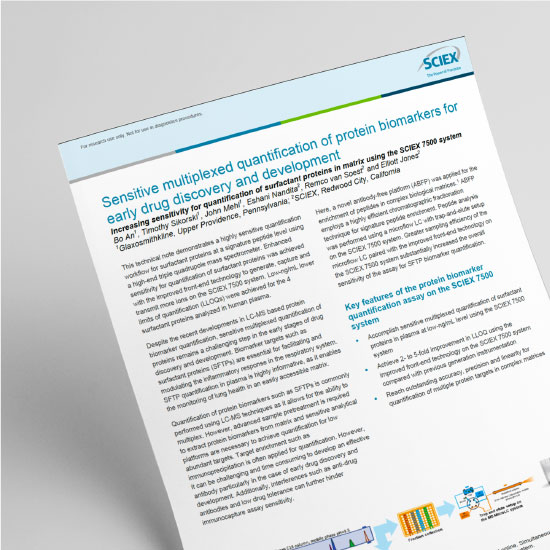
Sensitive multiplexed quantification of protein biomarkers for early drug discovery and development
This technical note demonstrates a highly sensitive quantification workflow for surfactant proteins at a signature peptide level using a high-end triple quadrupole mass spectrometer.
Clinical metabolomics and lipidomics
Clinical metabolomics and lipidomics analyze small molecules in clinical samples such as blood, urine and tissue. Metabolomics looks at metabolites involved in biological processes, while lipidomics focuses on lipids. These fields can provide insights into disrupted metabolic pathways in diseases and conditions, leading to new diagnostic and therapeutic approaches.
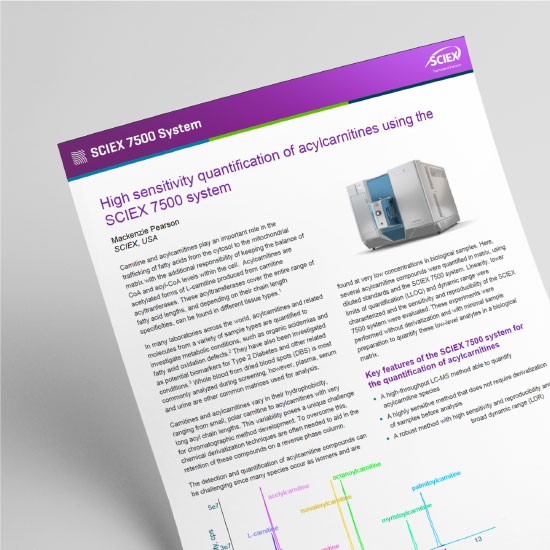
High sensitivity quantification of acylcarnitines using the SCIEX 7500 system
Carnitines and acylcarnitines are important biomarkers for many genetic disorders and can be present in low amounts in biological matrices. Here, using a simple sample preparation method and a fast LC gradient, 8 carnitines and acylcarnitines were monitored in rat plasma.
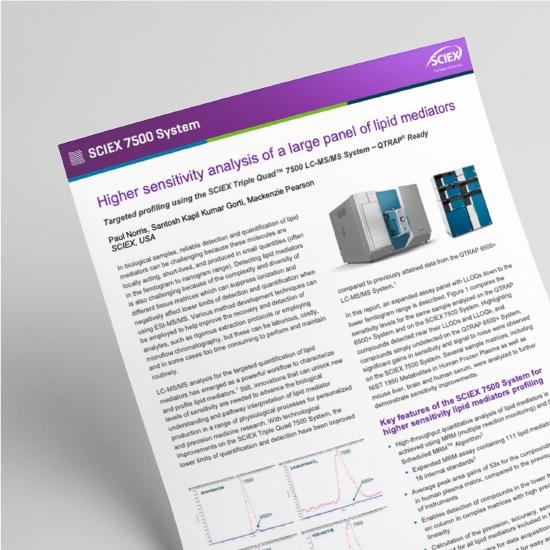
Higher sensitivity analysis of a large panel of lipid mediators
High sensitivity is key for the analysis of lipid mediators in human plasma. Here, a lipid mediator assay has been expanded and adapted to the SCIEX 7500 system using multiple reaction monitoring (MRM). The sensitivity level of the SCIEX 7500 system was compared to the QTRAP 6500+ system and average gain in peak areas was observed.
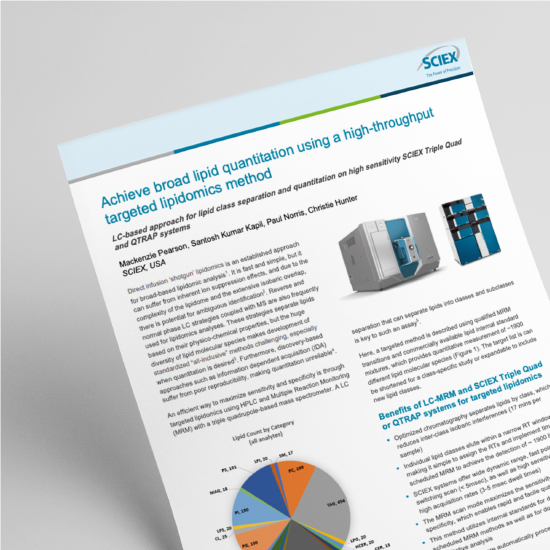
Achieve broad lipid quantitation using a high-throughput targeted lipidomics method
The complexity of the lipidome and a huge diversity in lipid molecular species makes comprehensive quantitative profiling challenging. In this work, a targeted lipid profiling method has been developed for the quantitation of a large panel of lipid molecular species (~1,900 molecular species).
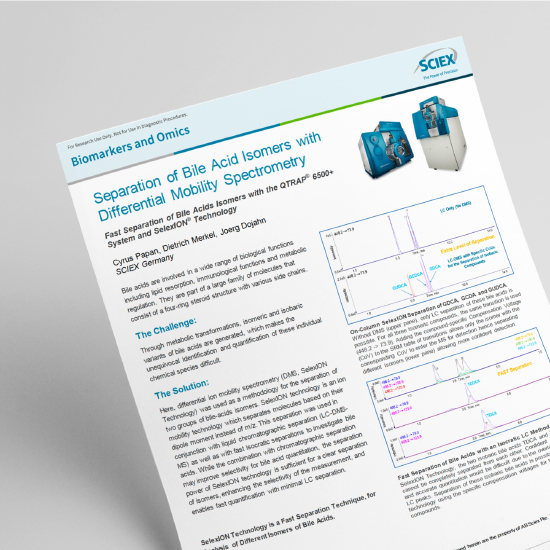
Separation of bile acid isomers with differential mobility spectrometry
Bile acids are involved in a wide range of biological functions , including lipid resorption, immunological functions and metabolic regulation. Isomeric and isobaric variants of bile acids can be generated during metabolic transformations, making identification and quantitation difficult. Here, a differential mobility spectrometry (DMS) approach enabled the separation of 2 groups of bile acid isomers.
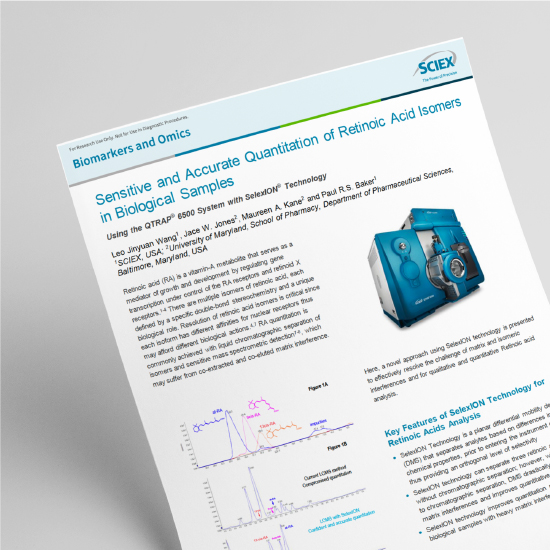
Sensitive and accurate quantitation of retinoic acid isomers in biological samples
Retinoic acid has multiple isomers with different specific double-bond stereochemistry and different biological roles. Since these cause different biological effects, it is best to separate and quantify the isomers. Here, a differential mobility spectrometry (DMS) approach using the SelexION device enabled the separation of the retinoic acid based on their structural differences. In combination with LC-MS/MS, a specific targeted method for quantitation of retinoic acid isomers in biological matrices is demonstrated.
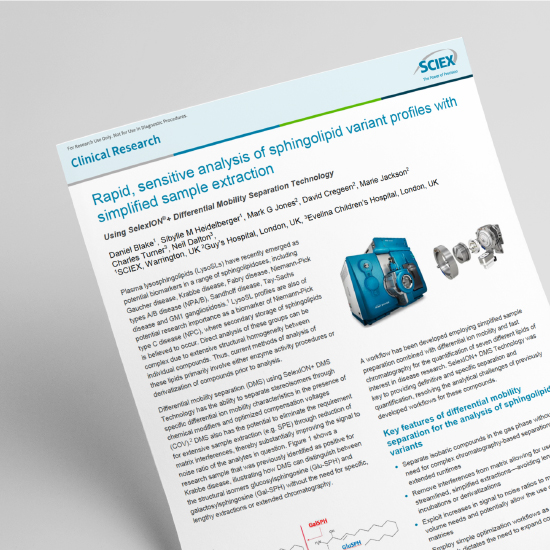
Rapid, sensitive analysis of sphingolipid variant profiles with simplified sample extraction
Plasma lysosphingolipids (LysoSLs) have recently emerged as potential biomarkers in a range of sphingolipidoses. Current methods of analysis primarily involve either enzyme activity procedures or derivatization of compounds prior to analysis. Direct analysis of these groups can be complex due to extensive structural homogeneity between individual compounds. Here, 7 different lipids were quantified using simplified sample preparation combined with differential mobility spectrometry (DMS) and fast chromatography.